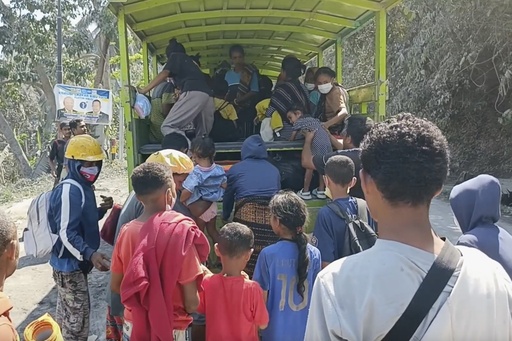
JAKARTA, Indonesia — A series of powerful eruptions from Mount Lewotobi Laki Laki on Indonesia’s remote Flores Island resulted in the deaths of nine individuals and left many others wounded. The chaos forced residents to flee in panic as buildings collapsed around them in the dark.
The eruptions took place on Monday, impacting over 10,000 individuals across ten villages. In the aftermath, approximately 4,400 locals sought refuge in temporary shelters after the catastrophe destroyed seven educational institutions, nearly twenty houses, as well as a convent on the island, predominantly inhabited by Catholics.
On Wednesday, officials began distributing significant amounts of logistical and aid supplies to those who were displaced by the disaster. They issued warnings to the thousands who fled, advising them against returning to their homes. Meanwhile, rescue teams comprising police and military personnel continued searching the hard-hit areas for any signs of survivors, although there have not been any reports of missing persons.
The phrase “how many active volcanoes are there in Indonesia?” comes to mind, as Mount Lewotobi Laki Laki stands at 1,584 meters (5,197 feet) and is one of the country’s 120 active volcanoes. Indonesia, situated along the Pacific Ocean’s “Ring of Fire,” is susceptible to earthquakes, landslides, and volcanic activity due to its geographical positioning.
According to Indonesia’s Center for Volcanology and Geological Disaster Mitigation, the country has recorded nearly 4,800 volcanic eruptions across the extensive archipelago since the beginning of the year. Mount Ibu in North Maluku has erupted 1,930 times, followed by Mount Semeru in East Java with 1,634 eruptions, and Mount Lewotobi Laki Laki has seen 872 eruptions.
In January, approximately 6,500 individuals were evacuated as Mount Lewotobi Laki Laki began releasing thick clouds of ash, prompting the closure of the island’s Frans Seda Airport. Fortunately, there were no reports of casualties or significant damage, yet the airport remains shut due to ongoing volcanic activity.
Regarding the intensity of the recent eruptions, experts noted that Mount Lewotobi Laki Laki had been erupting consistently, with as many as six eruptions each day since January. However, a significant decrease in activity was observed in early November. Muhammad Wafid, the head of the geology agency at the Energy and Mineral Resources Ministry, explained that the volcano had experienced a blockage of magma in its crater. This blockage resulted in lower seismic activity but increased pressure, leading to the recent powerful eruptions.
Wafid indicated that the eruptions beginning on Friday resulted from a build-up of hidden energy, advising that the volcano’s alert level should be raised to the maximum tier. He stated, “Currently there is no technology that can conclusively determine when an eruption will happen or how massive it will be. What we can do is monitor the indicators of an impending eruption; the timing remains uncertain.”
As for the frequency of deadly eruptions in Indonesia, while many eruptions are minor and result in minimal damage, some have had serious consequences. In December 2023, Mount Marapi’s eruption led to the deaths of 24 climbers and injured others. The aftermath triggered the closure of two climbing routes.
Additionally, severe monsoon rains five months later caused a landslide of mud and cold lava from Mount Marapi, leading to overflowing rivers, devastating mountainside villages, and claiming 67 lives.
The eruption of Mount Semeru in December 2021, which is the highest volcano on the populous Java island, resulted in the deaths of 48 people and left 36 missing as villages became buried under thick layers of mud. Mount Merapi’s eruption in 2010 was particularly catastrophic, claiming the lives of 347 individuals and displacing 20,000 residents. Historically, the eruption of the Krakatau volcano in 1883 even led to a period of global cooling due to the magnitude of ash and debris released into the atmosphere.
